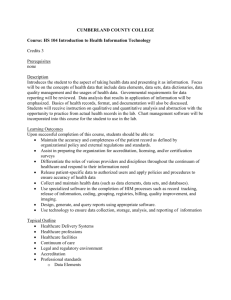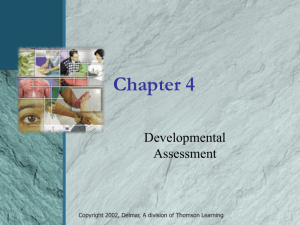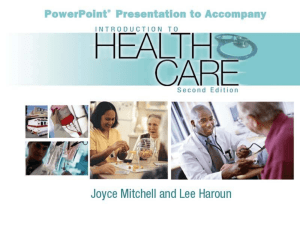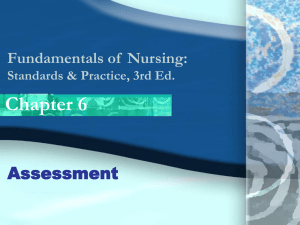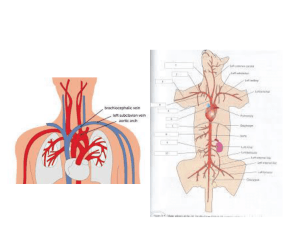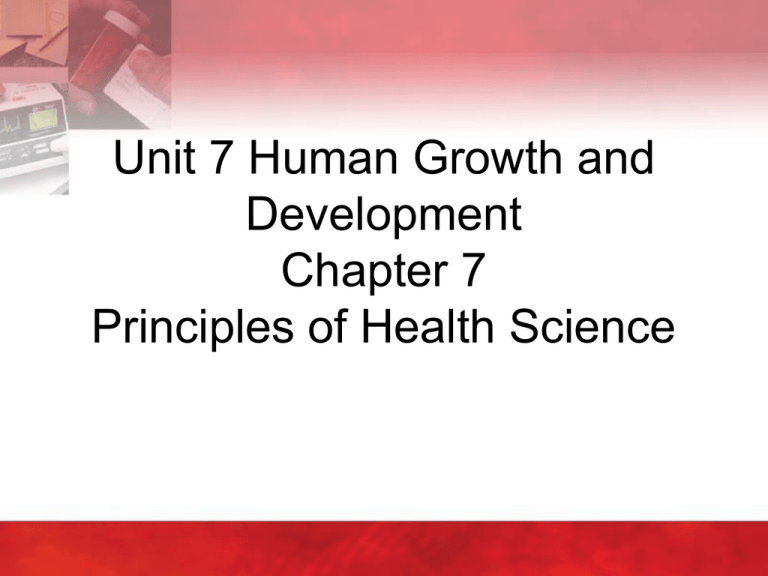
Unit 7 Human Growth and
Development
Chapter 7
Principles of Health Science
Life Stages
Growth and development begins at birth
and ends at death
During an entire lifetime, individuals have
needs that must be met
Health care workers need to be aware of
the various stages and needs of the
individual to provide quality health care
Copyright © 2004 by Thomson Delmar Learning. ALL RIGHTS RESERVED.
2
Life Stages
(continued)
Infancy: birth to 1 year
Early childhood: 1-6 years
Late childhood: 6-12 years
Adolescence: 12-20 years
Early adulthood: 20-40 years
Middle adulthood: 40-65 years
Late adulthood: 65 years and up
Copyright © 2004 by Thomson Delmar Learning. ALL RIGHTS RESERVED.
3
Growth and Development
Types
Physical: body growth
Mental: mind development
Emotional: feelings
Social: interactions and relationships
with others
All four types above occur in each stage
Tasks progress from simple to complex
Copyright © 2004 by Thomson Delmar Learning. ALL RIGHTS RESERVED.
4
Growth and Development
Rates
Rate of progress varies
Factors that can affect include:
– Sex
– Race
– Heredity
– Culture
– Life experiences
– Health status
Copyright © 2004 by Thomson Delmar Learning. ALL RIGHTS RESERVED.
5
Erikson’s Stages of
Psychosocial Development
Erik Erikson was a psychoanalyst
A basic conflict or need must be met in
each stage
See Table 7-1 in text page 191 & the
handout
Copyright © 2004 by Thomson Delmar Learning. ALL RIGHTS RESERVED.
6
Infancy
Age: birth to 1 year old
Dramatic and rapid changes
– Newborn average weight is 6-8 pounds
– Average length is 18-22 inches
Reflexes are present at birth
– Moro/startle
– Rooting
– Sucking
– Grasping
Teeth appear between 4-6 months of age. By age one 10-12 teeth.
Vision is poor at birth limited to black and white but by age 1 can
focus on small objects.
Copyright © 2004 by Thomson Delmar Learning. ALL RIGHTS RESERVED.
7
Infancy Physical Development
AGE:
ACTIVITY:
BIRTH
lift head slightly
2 MONTHS
roll side to back
4-5 MONTHS
turn body completely around, accept objects handed to
them, grasp stationary objects, hold head up while sitting
6-7 MONTHS
sit unsupported for several minutes, grasp moving
objects, crawl on the stomach
12 MONTHS
walk without assistance, grasp with thumb and fingers,
throw objects
Copyright © 2004 by Thomson Delmar Learning. ALL RIGHTS RESERVED.
8
Infancy Development
Mental– Rapid in the 1st year.
– Responds to discomforts by crying.
– By 6 months make basic sounds
– By 12 months understand and use single words.
Emotional– Newborns show excitement
– At 12 months, affection for parents is evident.
Social– 4 months – recognizes/smiles at caregiver.
– 6 months- watches the activities of others.
– 12 months – shy with strangers, but socializes with familiar people.
REMEMBER, stimulation is essential for mental growth.
https://www.youtube.com/watch?v=T7lL1jnwZOs
Copyright © 2004 by Thomson Delmar Learning. ALL RIGHTS RESERVED.
9
Early Childhood
Age: 1-6 years old
Physical Development
Growth slows down
At age 6 average height – 46 inches, average weight – 45 pounds
Has more adult appearance – head more in proportion to the rest of
the body.
Muscle coordination – allows the child to run and climb
Learn to write and draw and use a fork and knife.
2-3 years – most of the teeth developed – can eat adult foods
2-4 years – establishment of bowel and bladder control.
Copyright © 2004 by Thomson Delmar Learning. ALL RIGHTS RESERVED.
10
Early Childhood
Mental development:
Advances rapidly
Verbal – several words at age one to 1500-2000 words at age 6.
Two years – short attention span.
Four years – ask many questions, recognizes letters and some
words and begins to make logic based decisions.
Six years – learns to read and write, and makes decisions based on
the present and the past.
Copyright © 2004 by Thomson Delmar Learning. ALL RIGHTS RESERVED.
11
Early Childhood
Emotional development:
At age 2 safety limits are defined & child will accept or defy the limits.
Become impatient and frustrated when they try to do things beyond their
ability.
Temper tantrums – when can’t perform as desired.
Likes routine
Age 4-6: Understands right from wrong.
Less anxiety when faced with new situations.
Social Development
Expands form a self-centered one-year-old to a very sociable six-year-old.
Still has a need for routine, order, and consistency in daily lives.
https://www.youtube.com/watch?v=7Qb3DXY_7fU
Copyright © 2004 by Thomson Delmar Learning. ALL RIGHTS RESERVED.
12
Late Childhood or
Preadolescence
Age: 6-12 years old
Physical development
Slow but steady
Weight gain 5-7 pounds/year; height gain of 2-3 inches/year
Most primary teeth are lost and replaced by permanent teeth.
Age 10-12 - sexual maturation begins.
Mental development
Learns to use information to solve problems
Memory becomes more complex
Begins to understand more abstract concepts such as loyalty,
honesty, values, and morals.
Copyright © 2004 by Thomson Delmar Learning. ALL RIGHTS RESERVED.
13
Late Childhood or
Preadolescence
Emotional Development
Age 6 often frightened as school begins. Reassuring
parents can ease this transition.
Age 10-12 sexual maturation and changes in body
functions can lead to periods of depression followed by
joy.
Social Development
7 years-tend to like activities they can do by themselves.
8-10 years-tend to be more group orientated.
10-12 years-make friends more easily & gain interest in
https://www.youtube.com/watch?v=sUS-5p7CPuE.
the opposite sex
https://www.youtube.com/watch?v=sUS-5p7CPuE
14
Adolescence
Age: 12-20 years old
Physical development
Sudden growth spurt can cause rapid increases in weight and height.
Occurs between ages 11-13 for girls; and between ages 13-15 for boys.
Muscle coordination does not occurs as quickly, and can lead to clumsiness or
awkwardness during this period.
Onset of puberty; secretion of sex hormones begin
Girls
– Menstruation
– Pubic hair
– Hips widen
– Develop breasts
– Body fat distribution leads to the female shape.
Boys
– Production of semen and sperm
– Deeper voice
– More muscle mass
– Pubic and facial hair.
15
Adolescence
Mental Development
Most foundations established and experience increase of
knowledge and sharpening of skills.
Make independent decisions and accept responsibility
for actions
Emotional development:
Often stormy and in conflict
Worry about appearance, abilities and relationships with
others.
Social development:
Move away from family to association with peers.
Copyright © 2004 by Thomson Delmar Learning. ALL RIGHTS RESERVED.
16
Eating Disorders
Anorexia nervosa
Drastically reduce or
refuse food intake
Metabolic disturbances
occur
Weakness and death
Psychological
More common in females
Bulimia
Alternately binges
Eat excessively then fast
or refuse to eat
Induce vomiting
Use laxatives
Psychological
More common in females
Copyright © 2004 by Thomson Delmar Learning. ALL RIGHTS RESERVED.
17
Chemical Abuse
Use of substances such as alcohol or drugs
Reasons for trying chemicals:
–
–
–
–
–
–
–
–
Anxiety
Stress relief
Peer pressure
Escape from emotional or psychological problems
Experimentation with feeling the chemical produces
Instant gratification
Heredity traits
Cultural influences
Copyright © 2004 by Thomson Delmar Learning. ALL RIGHTS RESERVED.
18
Suicide
One of the leading causes of death in
adolescents
Reasons
– Depression
– Grief over a loss or love affair
– Failure in school
– Inability to meet expectations
– Influence of suicidal friends
– Lack of self-esteem
Copyright © 2004 by Thomson Delmar Learning. ALL RIGHTS RESERVED.
19
Increased Risk of Suicide
Family history of suicide
A major loss or disappointment
Previous suicide attempts
Recent suicide of friends, family, or role
models (heroes or idols)
Copyright © 2004 by Thomson Delmar Learning. ALL RIGHTS RESERVED.
20
Early Adulthood
Age 20-40 years
Physical development
Frequently the most productive period of life.
Physical development is basically complete.
Prime child-bearing years and usually produces the healthiest
babies.
Mental development
Time to make many decisions and form many judgments
–
–
–
–
–
–
Independence
Career choices
Establish life style
Select marital partner
Start a family
Establish values
Copyright © 2004 by Thomson Delmar Learning. ALL RIGHTS RESERVED.
21
Early Adulthood
Emotional development
Subjected to many emotional stresses related to
career, marriage, and family
Social development
Move away from peer group.
Associate with others who have similar
ambitions and interests (regardless of age)
Spend more time with mate and family of their
own
Copyright © 2004 by Thomson Delmar Learning. ALL RIGHTS RESERVED.
22
Middle Adulthood
(Middle Age)
Age: 40-65 years of age
Physical changes begin to occur
–
–
–
–
–
–
Hair gray and thins
Skin wrinkles
Muscle tone decreases
Hearing loss starts
Visual acuity declines
Weight gain
Mental development
Mental ability can continue to increase during this period
– usually very good students!
Copyright © 2004 by Thomson Delmar Learning. ALL RIGHTS RESERVED.
23
Middle Adulthood
Emotional development
Period of contentment and satisfaction , or a time of
crisis.
Satisfaction derived from: job stability, financial success,
the end of child- rearing, and good health.
Stresses can result from: loss of job, fear of aging, loss
of youth and vitality, illness, martial problems , and
“empty-nest” syndrome.
Social development
Relationships between husband and wife can become
stronger as a result of have more time to spend with
each other.
However, divorce rates are also high in this group.
Copyright © 2004 by Thomson Delmar Learning. ALL RIGHTS RESERVED.
24
Late Adulthood
Age: 65 years of age and up
Physical development
Often referred to as elderly or senior citizen
People are living longer
Physical development on the decline:
–
–
–
–
–
–
–
–
–
–
–
Skin-dry, wrinkled, thin with brown or yellow spots
Loss of hair or thins, gray, loss of shine
Bones become brittle and porous
Cartilage thins
Decrease muscle strength and tone
Hearing and vision loss
Decreased tolerance for heat and cold
Memory loss and decline of reasoning ability
Decreased circulation
Decreased lung capacity
Less efficient kidney & bladder
Copyright © 2004 by Thomson Delmar Learning. ALL RIGHTS RESERVED.
25
Late Adulthood
Mental development
Mental abilities vary among individuals.
Short-term memory is usually the first to decline.
Alzheimer’s disease can lead to irreversible loss of memory, and
deterioration of intellectual function.
Emotional Development
Some people cope well with the stresses presented by aging and
remain happy and able to enjoy life.
Others become lonely, frustrated, withdrawn, and depressed.
Stress can be the result of:
–
–
–
–
Retirement
Spouse or friend’s death
Physical disabilities
Financial problems
-Loss of Independence
-Knowledge of death impending
Copyright © 2004 by Thomson Delmar Learning. ALL RIGHTS RESERVED.
26
Late Adulthood
Social development
Retirement can lead to a loss of self-esteem.
Less contact with co-workers can lead to a limited circle
of friends.
Death of a spouse and friends, and moving to a new
environment can cause changes in social relationships.
Development of new social outlets is important:
Remember, no matter what the age, people need a
sense of belonging, self-esteem, financial security, social
acceptance, and love.
https://www.youtube.com/watch?v=ld8GLIzIWKU
Copyright © 2004 by Thomson Delmar Learning. ALL RIGHTS RESERVED.
27
7:2 Death and Dying
Death is “the final stage of growth”
Experienced by everyone and
no one escapes
Young people tend to ignore its existence
Usually it is the elderly, who have lost
others, who begin to think about their
own death
Copyright © 2004 by Thomson Delmar Learning. ALL RIGHTS RESERVED.
28
Terminal Illness
Disease that cannot be cured and will
result in death
People react in different ways
Some patients view death as a final peace
Copyright © 2004 by Thomson Delmar Learning. ALL RIGHTS RESERVED.
29
Research
Dr. Elizabeth Kübler-Ross was the leading
expert in the field of death and dying
Results of her research
– Most medical personnel now believe patient
should be informed of approaching death
– Patient should be left with some hope and
know they will not be left alone
– Staff need to know extent of information
known by patient
Copyright © 2004 by Thomson Delmar Learning. ALL RIGHTS RESERVED.
30
Research
(continued)
Dr. Kübler-Ross identified 5 stages of
grieving
– Dying patients and their families/friends may
experience these stages
– Stages may not occur in order
– Some patients may not progress through
them all, others may experience several
stages at once
Copyright © 2004 by Thomson Delmar Learning. ALL RIGHTS RESERVED.
31
Stages of Death and Dying
Denial – refuses to believe
Anger – when no longer able to deny
Bargaining – accepts death, but wants
more time
Depression – realizes death will
come soon
Acceptance – understands and accepts
the fact they are going to die
Copyright © 2004 by Thomson Delmar Learning. ALL RIGHTS RESERVED.
32
Caring for the Dying Patient
Very challenging, but rewarding work
Supportive care
Health care worker must have
self-awareness
Common to want to avoid feelings by
avoiding dying patient
Copyright © 2004 by Thomson Delmar Learning. ALL RIGHTS RESERVED.
33
Hospice Care
Palliative care only
Often in patient’s home
Philosophy: allow patient to die with dignity
and comfort
Personal care
Volunteers
After death contact and services
Copyright © 2004 by Thomson Delmar Learning. ALL RIGHTS RESERVED.
34
Right to Die
Health care workers must understand
this issue
Ethical issues must be addressed
Allowing patients to die can cause conflict
Specific actions to end life cannot be taken
Laws allowing “right to die”
Copyright © 2004 by Thomson Delmar Learning. ALL RIGHTS RESERVED.
35
Summary
Death is a part of life
Health care workers will deal with death
and dying patients
Must understand death and dying process
and think about needs of dying patients
Then health care workers will be able
to provide the special care these
individuals need
Copyright © 2004 by Thomson Delmar Learning. ALL RIGHTS RESERVED.
36
7:3 Human Needs
Needs: lack of something that is required
or desired
Needs exist from birth to death
Needs influence our behavior
Needs have a priority status
Maslow’s hierarchy of needs
(See Figure 7-14 in text)
Copyright © 2004 by Thomson Delmar Learning. ALL RIGHTS RESERVED.
37
Altered Physiological
Needs
Health care workers need to be aware
of how illness interferes with meeting
physiological needs
Surgery or laboratory testing
Anxiety
Medications
Loss of vision or hearing
Copyright © 2004 by Thomson Delmar Learning. ALL RIGHTS RESERVED.
38
Altered Physiological
Needs (continued)
Decreased sense of smell and taste
Deterioration of muscles and joints
Change in person’s behavior
What the health care worker can do to
assist the patient with altered needs
Copyright © 2004 by Thomson Delmar Learning. ALL RIGHTS RESERVED.
39
Meeting Needs
Motivation to act when needs felt
Sense of satisfaction when needs met
Sense of frustration when needs not met
Several needs can be felt at the same time
Different needs can have different levels
of intensity
Copyright © 2004 by Thomson Delmar Learning. ALL RIGHTS RESERVED.
40
Methods for Satisfying
Needs
Direct methods
– Hard work
– Set realistic goals
– Evaluate situation
– Cooperate with others
Copyright © 2004 by Thomson Delmar Learning. ALL RIGHTS RESERVED.
41
Methods for Satisfying
Needs (continued)
Indirect methods
– Defense mechanisms
– Rationalization
– Projection
– Displacement
– Compensation
– Daydreaming
Copyright © 2004 by Thomson Delmar Learning. ALL RIGHTS RESERVED.
42
Methods for Satisfying
Needs (continued)
Indirect methods (continued)
– Repression
– Suppression
– Denial
– Withdrawal
Copyright © 2004 by Thomson Delmar Learning. ALL RIGHTS RESERVED.
43
Summary
Be aware of own needs and
patient’s needs
More efficient and quality care can
be provided when know needs and
understand motivations
Better understanding of our behavior
and that of others
Copyright © 2004 by Thomson Delmar Learning. ALL RIGHTS RESERVED.
44
7:4 Effective Communications
Health care workers must be able to relate
to patients, family, coworkers, and others
Understanding communication skills
assists in this process
Communication: exchange of information,
thoughts, ideas, and feelings
Copyright © 2004 by Thomson Delmar Learning. ALL RIGHTS RESERVED.
45
Effective Communications
(continued)
Verbal: spoken words
Written
Nonverbal: facial expressions, body
language, and touch
Copyright © 2004 by Thomson Delmar Learning. ALL RIGHTS RESERVED.
46
Effective Communications
(continued)
Essential elements
– Sender
– Message
– Receiver
– Feedback
Copyright © 2004 by Thomson Delmar Learning. ALL RIGHTS RESERVED.
47
Effective Communications
(continued)
Message must be clear
How sender delivers message
How receiver hears message
How receiver understands message
Avoid interruptions and distractions
Copyright © 2004 by Thomson Delmar Learning. ALL RIGHTS RESERVED.
48
Listening
Essential to communications
Attempt to hear what other is really saying
Need constant practice
Good listening skills techniques
Observe speaker closely
Reflect statements back to speaker
Copyright © 2004 by Thomson Delmar Learning. ALL RIGHTS RESERVED.
49
Nonverbal Communications
Facial expressions, body language,
gestures, eye contact, and touch
Can conflict with verbal message
Be aware of own and other’s nonverbals
Don’t always need verbals to
communicate effectively
When verbal and nonverbal agree,
message more likely understood
Copyright © 2004 by Thomson Delmar Learning. ALL RIGHTS RESERVED.
50
Barriers to Communication
Something that gets in the way of clear
communications
Common barriers
– Physical disabilities
– Psychological attitudes and prejudice
– Cultural diversity
Copyright © 2004 by Thomson Delmar Learning. ALL RIGHTS RESERVED.
51
Recording and Reporting
Observe and record observations
Use all senses in the process
Report promptly and accurately
Criteria for recording observations on a
patient’s health care record
Copyright © 2004 by Thomson Delmar Learning. ALL RIGHTS RESERVED.
52
Summary
Good communication skills
allow development of
good interpersonal relationships
Health care worker also relates
more effectively with coworkers and
other individuals
Copyright © 2004 by Thomson Delmar Learning. ALL RIGHTS RESERVED.
53


